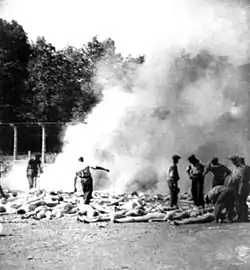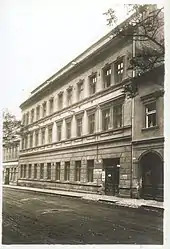Aryanization
Aryanization (German: Arisierung) was the forced expulsion of Jews from business life in Nazi Germany, Axis-aligned states, and their occupied territories. It entailed the transfer of Jewish property into "Aryan" hands in order to "de-Jew the economy".

The process started in 1933 in Nazi Germany with transfers of Jewish property and ended with the Holocaust.[1][2] Two phases have generally been identified: a first phase in which the theft from Jewish victims was concealed under a veneer of legality, and a second phase, in which property was more openly confiscated. In both cases, Aryanization corresponded to Nazi policy and was defined, supported, and enforced by Germany's legal and financial bureaucracy.[3][4][5][6][7]
Before Hitler came to power, Jews owned 100,000 businesses in Germany. By 1938, boycotts, intimidation, forced sales, and restrictions on professions had largely forced Jews out of economic life. According to Yad Vashem, "Of the 50,000 Jewish-owned stores that existed in 1933, only 9,000 remained in 1938."[8]
Michael Bazyler writes that "[t]he Holocaust was both the greatest murder and the greatest theft in history"; between $230 and $320 billion (in 2005 [US] dollars) was stolen from Jews across Europe.[9]
Nazi Germany
Exclusion of Jews
Starting in 1933, through the Aryan paragraph and later the Nuremberg Laws, Jews were largely excluded from public life. Reserved areas in the economy had been left to them, which Aryanization was to do away with. They were removed from jobs in the public sector, such as the civil service and teaching, and further restrictions were introduced through the Nazi period. Jewish university faculty were removed from departments in German universities in cities including Hamburg, Berlin, Frankfurt am Main, Breslau, Heidelberg, Bonn, Cologne, Würzburg, and Jena.[10]
Later on, an increasing number were incarcerated in Nazi concentration camps, and finally deported to the east where they were murdered directly in death camps or shot by the Einsatzgruppen.
Theft of property

By 1 January 1938, German Jews were prohibited from operating businesses and trades and offering goods and services. On 26 April 1938, Jews were ordered to report all wealth over 5,000 Reichsmarks, and their access to bank accounts was restricted. On 14 June 1938, the Interior Ministry ordered the registration of all Jewish businesses. The state set the sales value of Jewish firms at a fraction of their market worth, and used various pressure tactics to ensure sales only to desired persons. Among the largest "Aryanization profiteers" were IG Farben, the Flick family, and large banks. The proceeds from "Aryanized" firms had to be deposited in savings accounts, and were made available to their Jewish depositors only in limited amounts, so that in the final analysis, Aryanization amounted to almost compensation-free confiscation.
In the autumn of 1938, only 40,000 of the formerly 100,000 Jewish businesses were still in the hands of their original owners. Aryanization was completed on 12 November 1938 with the enactment of a regulation, the Verordnung zur Ausschaltung der Juden aus dem deutschen Wirtschaftsleben (Regulation for the elimination of Jews from German economic life), through which the remaining businesses were transferred to non-Jewish owners and the proceeds taken by the state. Jewellery, stocks, real property, and other valuables had to be sold. Either by direct force, government interventions such as sudden tax claims, or the weight of the circumstances, Jewish property changed hands mostly below fair market value. Jewish employees were fired, and self-employed people were prohibited from working in their respective professions.
Kristallnacht



After the "Kristallnacht" pogroms, the pressure of Aryanization was drastically increased. On 12 November 1938, Jews were forbidden to function as business managers, forcing Jewish owners to install "Aryan" surrogates. These people, who were often promoted by the party, first took over the office, and soon thereafter usually the whole business. "Compliant Aryans" (Gefälligkeitsarier) were threatened with punishment according to the Regulation against Complicity with the Camouflage of Jewish Firms (22 April 1938). Because the Jews were burdened with heavy payments as "atonement" for the damage done by the SA and antisemitic mobs during Kristallnacht, the selling off of Jewish property was only a question of time. On 3 December 1938, the value of Jewish landed property was frozen at the lowest level, and valuables and jewels were permitted to be sold only through state offices. The impoverishment of the Jewish population caused by Aryanization often stood in the way of its goal — promoting emigration through persecution — because those affected lacked the means to emigrate. They became victims of the Final Solution. Aryanization combined the racial motives of National Socialism with traditional antisemitic resentments within the middle classes (Mittelstand) and the expansionist tendencies of big business. The fear of being too late to share in the booty produced a fateful coalition of greed, so little opposition to Aryanization arose. After the war, the Federal Republic of Germany paid some restitution for the material losses.
Many important businesses were sold and re-sold in the course of the process, some of which (such as the Hertie department store) played an important role during the post-war Wirtschaftswunder years in West Germany. Victims who were murdered by the Nazis in the camps were deprived of their last remaining property such as gold teeth, wedding rings, hair, and all clothing. Body cavities were also searched for any hidden valuables by the Sonderkommando.
In a broader sense, the term Aryanization is sometimes used to refer to eviction of Jewish scientists and people engaged in the cultural sector.
Romania
In Romania, the Aryanization process was encouraged by tax incentives, as well as outright confiscation. Hardliners complained that some Jews were able to evade the regulations by transferring their businesses to Romanian owners (only on paper). Although Aryanization was to an extent inspired by similar policies in Germany, the Romanian authorities made the key decisions with regards to the implementation of Aryanization.[12]:49
Slovakia
Aryanization also occurred in the Slovak State. About 12,300 Jewish businesses existed in 1940. By 1942, 10,000 had been liquidated, and the remainder "Aryanized" by transfer to non-Jewish owners.[13]
In popular culture
- The 1965 Oscar-winning Czechoslovak film The Shop on Main Street (Obchod na korze) addressed Aryanization in the Slovak State.
See also
References
Notes
- Bopf, Britta (2004). "Arisierung" in Köln: Die wirtschaftliche Existenzvernichtung der Juden 1933-1945. Cologne: Emons Verlag Köln. ISBN 389705311X.
- Shoah Resource Center. "Aryanization" (PDF). Yad Vashem. Yad Vashem. Retrieved 1 December 2017.
- "Confiscation of Jewish Property in Europe, 1933–1945 New Sources and Perspectives Symposium Proceedings" (PDF). UNITED STATES HOLOCAUST MEMORIAL MUSEUM CENTER FOR ADVANCED HOLOCAUST STUDIES. 2003. Archived from the original (PDF) on 2 December 2017. Retrieved 2 December 2017.
Particularly impressive and equally disturbing is the robbers’ effort to ensure that property confiscation was carried out by "legal" means through a vast array of institutions and organizations set up for this purpose. The immensely bureaucratic nature of the confiscation process emerges from the vast archival trail that has survived. Arguments that no one knew about the Jews’ fate become untenable once it is clear how many people were involved in processing their property. "Legal" measures often masked theft, but blatant robbery and extortion through intimidation and physical assault were also commonplace.
- Döblin, Alfred. "Plünderung jüdischen Eigentums Billigende Inkaufnahme "Wie Deutsche ihre jüdischen Mitbürger verwerteten": Die Enteignung der Juden ist gut dokumentiert. Wolfgang Dreßen hat die Akten gesichtet". TAZ. Retrieved 2 December 2017.
- Kieser, Albrecht (February 15, 2006). "Späte Enthüllungen An der Aufklärung über Arisierungen ist man in Deutschland noch immer nicht sonderlich interessiert". Telopolis. Heise Online. Archived from the original on December 2, 2017. Retrieved 2 December 2017.
- "Das Finanzamt Moabit-West "verwertete" das Hab und Gut jüdischer Opfer des Nationalsozialismus". Berline Woche. Berline Woche. Retrieved 2 December 2017.
- ""Arisierung" in Köln". Portal Rheinische Geschichte. Landschaftsverband Rheinland. Retrieved 2 December 2017.
- Shoah Resource Center. "Aryanization" (PDF). Yad Vashem. Yad Vashem. Retrieved 1 December 2017.
- Bazyler, Michael J. (2005). Holocaust Justice: The Battle for Restitution in America's Courts. NYU Press. p. xi. ISBN 978-0-8147-2938-0.
- Zeidman, Lawrence A. (2020). Brain Science Under the Swastika: Ethical Violations, Resistance, and Victimization of Neuroscientists in Nazi Europe. Oxford University Press. p. 139-207. ISBN 978-0-19-872863-4.
- Nyiszli, Miklós (2011). "Chapter III". Auschwitz: A Doctor's Eyewitness Account. Translated by Richard Seaver. New York: Arcade Publishing. pp. 53–55. ISBN 9781611450118. OCLC 761307497.
- Panu, Mihai–Adrian (May 2015). "The Ideological Dimension of Aryanization Politics in Interwar Romania". Procedia - Social and Behavioral Sciences. 183: 47–52. doi:10.1016/j.sbspro.2015.04.844.
- "Liquidation of Jewish enterprises". National Memory Institute. Retrieved 11 December 2018.
Bibliography
- Zentner, Christian and Bedürftig, Friedermann (1991). The Encyclopedia of the Third Reich. New York: Macmillan. ISBN 0-02-897502-2
External links
- Aryanization on the Yad Vashem website
- Newspaper clippings about Aryanization in the 20th Century Press Archives of the ZBW